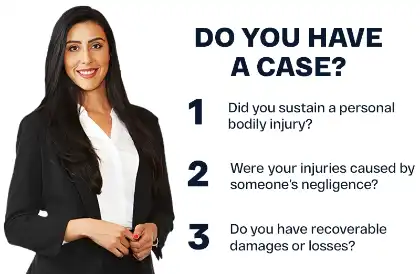Ontario Workplace Injury Lawyers
We’ll tell you if you have a case or not, call (888) 488-1391 — We’re here 24 hours a day.
Our Workplace Injury Lawyers Offer Legal Help For Life-Changing Moments
Workplace injuries can happen on construction sites, in warehouses, or in office settings. Beyond the physical pain, they can create financial strain and uncertainty about how to move forward. Our Ontario workplace injury lawyers at Arash Law work to help protect your rights and pursue compensation for your injuries and other losses. Call us at (888) 488-1391 for a free case evaluation.
Ontario is the third most populous city in San Bernardino County, California. Only about 35 miles east of downtown Los Angeles and less than 25 miles east of San Bernardino, the city expanded from the 0.38 square mile area originally incorporated in 1891 to almost 50 square miles. The city is served by three major railroads, the San Bernardino, Pomona, and Devore Freeways (Interstate 10, California State Route 60, and Interstate 15), and the Ontario International Airport.
Maglite, a brand of flashlight manufactured by Mag Instrument, Inc., is located in Ontario, but the local economy relates more to service industries and manufacturing, with Cardinal Health, AutoZone, Genuine Parts/NAPA, Meadowbrook Meat Company (MBM), and Nordstrom being among the companies with major distribution centers in the city. The city’s own Comprehensive Annual Financial Report showed that the Ontario International Airport, Safariland, Sam’s Club Distribution, Securitas, Target Distribution, and United Parcel Service (UPS) were the largest employers in Ontario.
According to the 2020 United States Census, Ontario had a population of over 170,000. Ontario residents were 69.9% Hispanic or Latino, 40.9% were white alone, 18.0% were two or more races, 7.0% were Asian alone, 5.7% were Black or African American alone, and 1.4% were American Indian and Alaska Native alone.
Ontario is a busy city in California where a significant number of workers require medical attention each year for various job-related injuries. Filing a workplace injury claim may not be straightforward, as the process can involve complex rules and insurance company procedures. In such cases, Ontario workplace injury lawyers provide legal guidance by helping workers understand their rights and exploring available options for pursuing compensation after a workplace accident.
A farm worker, suffered multiple broken bones and other orthopedic injuries resulting from an auto accident where the defendant driver attempted to make a left turn in front of our client in heavy fog.– ARASH KHORSANDI
Important Workplace Injury Statistics
The United States Bureau of Labor Statistics (BLS) reported 5,190 fatal work injuries in the United States in 2021, an 8.9-percent increase from 4,764 in 2020. The BLS also reported that there were 2,607,900 nonfatal injuries and illnesses, with California specifically having 462 fatal injuries that included 142 transportation incidents, 103 instances of exposure to harmful substances or environments, 87 cases of violence and other injuries by individuals or animals, 78 falls, slips, or trips, and 44 instances of contact with objects and equipment.
The Health & Safety Institute notes that the Occupational Safety & Health Administration (OSHA) identified the four leading causes of fatalities in the construction industry that are known as the “Fatal Four,” OSHA’s “Focus Four Hazards,” or “Construction Focus Four Hazards”:
- Falls — 36.4% of construction fatalities in 2021.
- Caught-In or Caught-Between — 5.4% of construction fatalities.
- Struck by an Object — 15.4% of construction fatalities.
- Electrocutions — 7.2% of construction fatalities.
Whether someone lives or works in Ontario, a workplace injury can create financial challenges, including medical expenses and lost income. Navigating the workers’ compensation system or other legal options can feel complex without guidance.
Arash Law represents clients in the greater Ontario area in workplace injury matters. Our Ontario workplace injury lawyers offer legal guidance, explain available options, and assist clients in protecting their rights under California law.
How Does Workers’ Compensation Work In California?
Workers’ compensation provides many different kinds of benefits for workers for injuries or illnesses arising out of or caused by work, including medical care to treat an injury, temporary or permanent disability benefits, and possible job displacement benefits. Workers’ compensation can pay medical bills and benefits for temporary or permanent disabilities. However, some people may file Disability Insurance (DI) claims if their employer or employer’s workers’ compensation insurance carrier denies or delays workers’ compensation benefits, or a workers’ compensation weekly benefit amount is less than a DI weekly benefit amount. It’s worth noting that people cannot receive both workers’ compensation and DI benefits at the same time.
The California Department of Industrial Relations (DIR) reports that San Bernardino has gone from 27,881 workers’ compensation claims in 2010 to 43,878 in 2021, with a high of 45,375 in 2020 and 429,122 total claims filed between 2010 and 2021. DIR also reported that the 4.5 rate of injury per 100 employees was the third-highest in the state after the 5.2 in San Joaquin and 4.7 in Fresno.
Workers’ Compensation Eligibility In Ontario
Employers are required by law in California to pay for workers’ compensation benefits for their employees, meaning employers cannot rely on a simple general liability policy that will only offer protection for third-party claims. Workers’ compensation insurance provides five basic benefits:
- Medical Care — Paid for by an employer to help a person recover from an injury or illness caused by work.
- Temporary Disability Benefits — Payments when an employee loses income because their injury prevents them from doing their usual job while recovering.
- Permanent Disability Benefits — Payments are made when a person does not completely recover.
- Supplemental Job Displacement Benefits — Vouchers to help pay for retraining or skill enhancement if a person does not recover completely and cannot return to work for their employer.
- Death Benefits — Payments to spouses, children, or other dependents when a person dies from a job injury or illness.
Eligibility questions sometimes arise when workers are classified as independent contractors. However, job titles alone do not determine employment status. A worker may be considered an employee if the hiring party controls how the work is performed or has the right to terminate the worker. Other factors include being paid wages or a salary, having payroll taxes deducted, using tools or materials provided by the employer, or being required to follow a set schedule.
Statute Of Limitations For Workplace Injury Claims In Ontario
The California Labor Code establishes that a person has 30 days to notify their employer, in writing, that they suffered an injury. Notifying an employer of a job-related injury is not the same as filing a workers’ compensation claim.
To officially file a workers’ compensation claim, a person must file an Application for Adjudication of Claim and Declaration Pursuant to California Labor Code § 4906(g) with the Workers’ Compensation Appeals Board (WCAB). The statute of limitations for workers’ compensation claims in California is generally one year from the date of a job-related injury or illness. Missing this deadline may result in losing the right to pursue a claim.
If a person files a personal injury claim against an employer or a third party, the statute of limitations in California is generally two years from the date of the injury. Because deadlines can vary depending on the circumstances, it may be beneficial to consult with an Ontario personal injury lawyer to better understand how the law applies to your situation.
How Important Is An Ontario Workers’ Comp Lawyer?
In workers’ compensation cases, employees often have questions about their rights and the benefits they may be entitled to. A lawyer can help them better understand these complex matters, explain their options, and guide them through the process involved in securing benefits. Legal representation can be particularly crucial if there are disputes about whether an injury is work-related, if an employer takes retaliatory actions, or if injuries result from serious misconduct.
When People Should Contact A Workplace Injury Lawyer
Not everyone necessarily needs to hire an attorney for their workers’ compensation claims. Minor injuries that will not involve significant time away from work or medical attention may be filed on a person’s own and can be resolved without much issue.
Most people do not have any difficulty obtaining benefits for smaller injuries that are not as serious. All of that said, there is the possibility that an employer or insurance company can take issue with some aspect of a claim.
Here are some situations where consulting a workplace injury lawyer can be beneficial:
- An employer refusing to admit that an injury was work-related, denying a claim, or failing to pay benefits.
- A compensation amount is insufficient to cover medical expenses or lost earnings incurred after a workplace accident.
- An injury causing a temporary or permanent disability preventing a person from resuming their previous job, hindering their ability to perform work tasks, or making it impossible to re-enter the workforce.
- Receiving or planning to apply for Social Security benefits.
- Retaliation actions for filing a claim, including an employer cutting hours, reducing pay, making a work environment hostile, demoting a person, or terminating them entirely.
- An injury is caused by serious misconduct on the part of an employer or negligence by a third party.
How Can Ontario Workplace Injury Lawyers Help Me?
If you’ve been injured at work, an Ontario workplace injury lawyer can be helpful, particularly if it’s challenging to deal with claims adjusters and investigators. In some cases, employers may request that employees sign documents following an injury. An attorney can help ascertain the implications of signing such documents. Consulting with Ontario workplace injury lawyers can offer you guidance on the potential benefits and entitlements that may be available to you.Common Kinds Of Workplace Accidents In California
There are many different kinds of accidents that can cause injuries in California. Some of the most common types our Ontario workplace injury lawyers handle include, but are not limited to:- Motor vehicle accidents
- Slip-and-fall accidents
- Trips
- Falls from heights
- Electrocutions
- Struck by objects
- Transportation accidents
- Entanglements
- Repetitive stress injuries
- Chemical exposures
- Overexertion injuries
- Burns
- Toxic fumes
- Caught-between accidents
- Equipment malfunction
- Workplace accidents


Steps A Person Can Take After A Workplace Injury
When a person suffers an injury on the job, there are going to be three things they’ll likely have to do in these cases.
Notify The Employer Of The Injured Individual
DIR states that people should notify their supervisors of their injuries as soon as possible. California requires workplace injuries to be reported to employers within 30 days. Otherwise, people may lose their right to benefits.
See A Doctor
After sustaining an injury at work, a person can see their own primary care physician if they meet certain criteria. Specifically, they must have health care coverage for medical treatment unrelated to work injuries. Additionally, they should have provided their employer with written notice, known as a predesignation, before the injury occurred.
Lastly, their doctor must have agreed in advance to treat work-related injuries or illnesses. If a person has not predesignated a personal doctor, the employer or their insurance company will typically establish a medical provider network (MPN). This allows individuals to choose a doctor from within the network.
Consult Ontario Workplace Injury Lawyers
Getting legal guidance from our Ontario workplace injury lawyers can be beneficial for your workers’ compensation case. Their knowledge and experience can help clarify your rights, highlight potential challenges, and help you learn more about the necessary steps to take. This informed approach can help you tackle the challenges surrounding your case.
Mistakes People Should Avoid After A Workplace Injury In Ontario
After a workplace injury, there are certain actions that can complicate the claims process. Being aware of these common missteps may help injured workers protect both their health and their rights under California law.
Waiting Too Long
Delaying medical treatment or waiting too long to file a workers’ compensation claim can create difficulties. California law sets time limits for reporting and filing, and missing these deadlines may affect eligibility for benefits.
Returning To Work Too Soon
Some employers may want injured workers to return quickly, but going back before receiving proper medical clearance can create problems. Returning early may put their health at risk and could also affect eligibility for certain workers’ compensation benefits. It is generally acceptable to only accept a full medical release when a doctor says optimal medical improvement has been reached.
Settling For Too Little
Some injured workers may be offered lump-sum settlements. While this seems appealing, the amount offered may not reflect the full cost of ongoing medical needs or lost wages. Consulting with a workplace injury lawyer can provide guidance on whether a settlement adequately addresses long-term expenses.
Kinds Of Workers’ Compensation Benefits
Workers in California enjoy several rights relating to their health and compensation for any workplace injuries. People, in these cases, may be entitled to several different benefits.
Medical Treatment
Injured workers in California have the right to necessary medical treatment for injuries caused by on-the-job injuries. Employers or the employers’ workers’ compensation insurance provider may be responsible for providing all reasonable treatment for injuries suffered on the job.
Temporary Disability
Temporary disability benefits (also known as TD benefits) are payments a worker may pursue from a claims administrator if they cannot do their usual job while they are recovering from their injury or illness, and these benefits are not taxable. If a person can do some work while recovering but will earn less than they did before the injury, they may ask for temporary partial disability benefits. If a person cannot work at all while recovering, they might instead seek temporary total disability benefits. California has a minimum and maximum payment for people with temporary disabilities, with the minimum rate being $230.95 per week and the maximum being $1,570.71 per week in 2022.
Permanent Disability
Unlike temporary disability benefits, permanent disability benefits are reserved for people who are not expected to make a complete recovery. The benefits aim to cover loss of future earning capacity, which is calculated as a percentage of a person’s ability to compete in the labor market. Permanent disability payments are generally paid weekly, and payments are two-thirds of the amount of a person’s weekly income before the disability occurred.
Permanent partial disability is for people who are partially disabled with a rating of below 100%, although a higher disability rating can lead to more weeks of pay. Permanent total disability is for people who are 100% disabled (or between 70% and 90% disabled) and can prove their disabilities occurred from work, which may lead to weekly payments for the rest of their lives.
Lost Income
Any income a person loses during treatment of their injury may be covered.
Supplemental Job Displacement Voucher
When a person’s disability means they will have to find a new job or work in a different field, they may pursue a voucher to pay for education, job training, skill improvement, or vocational rehabilitation.
Death Benefits
In the event of a fatal work-related injury or illness, or when a workplace injury contributes to a person’s death, workers’ compensation may provide death benefits to qualifying dependents along with coverage for burial expenses.
Can I File A Workplace Injury Claim Against My Employer?
Workers’ compensation is intended to be the exclusive remedy for most workplace injuries, as employers are rewarded for offering workers’ compensation insurance by being immune from civil actions. All of that said, a person can still sue their employer if the employer intentionally causes the injury, the employer fraudulently conceals their connection to the injury, the employer acts in a dual capacity, or the employer does not carry workers’ compensation insurance.
Intentionally causing an injury can relate to an employer committing assault or battery, sexual assault, or intentional infliction of emotional distress. Fraudulent concealment issues often relate to hazardous workplaces in which employees are not aware that their health is impacted by their employment.
Dual capacity issues arise in cases in which employers act in multiple roles, such as when they are also the property owners in a premises liability claim. When an employer does not maintain workers’ compensation insurance, an employee is free to file a lawsuit against the employer.
California Workers’ Compensation Benefits Process
A workers’ compensation claim begins with a person suffering a work-related injury, and injuries can be immediate, or they can also be occupational illnesses or repetitive stress injuries that accumulate over the course of several months or years. A person needs to notify their employer of their injury, and the employer must give or mail the person a Workers’ Compensation Claim Form (DWC 1) within one working day after they report the injury or illness.
A person needs to determine their primary treating physician. When a person has a predesignated doctor or healthcare provider in writing with their employer before an injury, that doctor can serve as the primary treating physician for the work-related injury.
In all other cases, a person will need to choose a physician from an employer’s medical provider network (MPN) or health care organization (HCO), or the employer can select a physician for the person. A person will then receive their initial medical care and wait for a claims administrator to review their claim.
Once the claim is filed, the employee receives initial medical care while a claims administrator reviews the case. If the claim is accepted, treatment is covered under workers’ compensation benefits. If it is denied, the employee is not eligible for benefits unless the decision is successfully challenged through dispute resolution or appeal.
Throughout recovery, employees must continue following medical treatment. Depending on the extent of the injury, they may also qualify for temporary or permanent disability benefits.
Kinds Of Compensation For Workplace Accidents In California
In some cases, the benefits offered by a workers’ compensation insurance company may not fully address the financial and personal impact of an injury. Workers’ compensation typically covers medical expenses and certain wage losses, but it does not include damages such as pain and suffering.
If an employer’s conduct contributed to the injury, or if a third party was involved, an employee may have grounds for a personal injury claim in addition to or instead of a workers’ compensation case. These types of claims generally must be filed within two years of the injury under California law. Consulting with a personal injury lawyer can help clarify which options may be available.
A personal injury case has the potential to provide numerous kinds of economic damages to people, including awards for lost income, medical bills, or property damage. Non-economic damages in these cases can include pain and suffering, mental anguish, or loss of enjoyment of life.
When an employer is grossly negligent in their practices, then punitive damages can also be possible in a select few cases. California Civil Code § 3294 establishes that punitive damages, or exemplary damages, are available in cases in which an employer is guilty of oppression, fraud, or malice.
Accepting a workers’ compensation settlement generally means giving up the right to bring a lawsuit against the employer for the same injury. An injured worker cannot pursue compensation under both systems unless a third party, separate from the employer, is legally responsible for the accident.
When a third party contributes to a workplace injury or illness, it may be possible to pursue both a workers’ compensation claim and a personal injury action. In such situations, a workplace injury lawyer can guide you through the process.

Settlement in a motor vehicle accident; client suffered internal injuries.– JUDD ROSS ALLEN
Compensation Available To Injured Workers In Ontario, California
Most injured workers in Ontario will have three options for compensation when it comes to workplace injuries. People may be eligible for anywhere from one to all three kinds of the following claims:
- Workers’ Compensation Benefits — These are available through both California state and federal law. Most employees in the private sector can file for California workers’ compensation benefits. Government employees, as well as workers in some high-risk occupations, may seek benefits through federal programs.
- Social Security Disability Benefits — These benefits are only paid to workers with substantial work histories. People can apply for Social Security Disability Insurance (SSDI) while receiving workers’ compensation benefits, and they may qualify for both. The Supplemental Security Income (SSI) program also provides monthly payments to people with disabilities or blindness who have income and resources below specific financial limits.
- Personal Injury Compensation — This type of compensation is available for workers in Ontario who suffer injuries because of the negligence of other parties or product defects. Workers’ compensation insurance customarily prohibits personal injury lawsuits against employers, with a few exceptions.
What Workers’ Compensation Covers
One very common concern relating to workplace injuries is the types of damages that can be covered. Workers’ compensation generally covers all injuries that happen because of traumatic events, as well as long-term illnesses that a person develops during their employment or are worsened by their job duties.
Common kinds of injuries include:
- Neck and back injuries
- Eye injuries
- Shoulder injuries
- Leg injuries
- Arm injuries
- Repetitive stress injuries
- Occupational respiratory illnesses
- Concussions
- Fractures and broken bones
- Cuts, lacerations, and punctures
- TBIs
- Occupational dermatitis
- Spinal cord injuries
- Musculoskeletal disorders
- Dislocated joints
- Strains, sprains, or tears
- Burns
- Lacerations
- Noise-induced hearing loss
- Occupational cancers
- Stress and mental health illnesses
- Chemical poisoning
Frequently Asked Questions (FAQs) About Workplace Injuries
What Should I Do If I Suffer Injuries At Work In Ontario?
According to the California Department of Industrial Relations (DIR), employees should promptly report a workplace injury or illness to their employer and seek appropriate medical attention, including emergency care if necessary.
After reporting, the next step is to file a workers’ compensation claim. Some individuals choose to consult with a workplace injury lawyer for guidance before or during this process, particularly if they have concerns about how their claim may be handled.
It can also be helpful to document the circumstances of the injury. For example, if the injury resulted from a specific incident, taking photographs of the work area and the injuries themselves may provide useful evidence during the claims process.
What Are My Rights As An Injured Worker In Ontario?
Under California workers’ compensation laws, employees who are injured or become ill due to their work have certain legal rights. These include the right to:
- File a workers’ compensation claim for a job-related injury or illness.
- Receive medical evaluation and treatment from an authorized physician.
- Return to work once cleared by a medical professional.
- Obtain disability benefits if an injury or illness prevents a timely return to work.
- Appeal a denied claim or disputed decision by an employer or insurance carrier.
- Decline pressure from an employer to avoid filing a claim or to use personal health insurance for a work-related injury.
- Be free from retaliation, harassment, or discrimination for filing a claim.
- Seek legal representation during the workers’ compensation process.
Can I Prove A Repetitive Motion Injury Was Work-Related?
The BLS once reported that musculoskeletal disorders (MSDs) made up 33% of all injury and illness cases. To pursue workers’ compensation for a repetitive motion injury (RMI) or repetitive stress injury (RSI), an employee must show that the condition is connected to their job duties. This usually requires medical documentation, such as a physician’s opinion stating the injury is “more likely than not” work-related. Because these injuries develop gradually, clear evidence and medical evaluation are often essential in the claims process.
Who Will Pay For A Work-related Injury?
In California, employers are legally required to carry workers’ compensation insurance if they have one or more employees. When a worker suffers a job-related injury or illness, the employer’s workers’ compensation insurance generally covers the cost of benefits, which may include medical care and disability payments as provided by law.
Will Work-Related Injuries Be Covered Under Workers’ Compensation?
Most job-related injuries and illnesses are covered by workers’ compensation. However, there are exceptions. Claims may not be covered if the injury was self-inflicted, resulted from fighting or horseplay, occurred while committing a crime, or involved drug or alcohol use. Coverage may also be denied if the injury violated company policy or involved certain stress or psychiatric disorders not tied to a specific workplace event.
Are People Still Paid If They Get Hurt At Work?
Employees who qualify for workers’ compensation may be eligible for benefits such as medical treatment and disability payments. These benefits are paid through the employer’s workers’ compensation insurance. The amount and duration of payments depend on the nature of the injury and the applicable laws.
If I Cannot Return To Work, Does My Employer Have To Hold My Job Open For Me?
If you cannot return to your job because of your injury, your employer may not necessarily hold the job for you. California Labor Code § 132a establishes that it is illegal for an employer to fire an employee due to a work injury. Although an employer is not required to rehire an injured worker, failing to provide a legitimate business reason for not doing so may result in a discrimination claim.
If I Cannot Return To The Type Of Work I Did Before I Suffered An Injury, What Can I Do?
Speak With Our Ontario Workplace Injury Lawyers
Arash Law assists individuals with workplace injury claims throughout California. Our team is familiar with the workers’ compensation and personal injury process and can guide clients through each stage of their case. Consulting with an attorney can help you better understand your legal options, particularly in situations where claims become complex or disputed.
Our Ontario workplace injury lawyers can review the circumstances of your injury, help gather supporting evidence, and offer guidance on the next steps in pursuing a claim. We can also work with medical providers for proper documentation of your injuries and treatment, which may be important in the claims process.
Our Ontario workplace injury lawyers also serve surrounding areas, including Montclair, Upland, Rancho Cucamonga, Chino, Pomona, Claremont, La Verne, Chino Hills, Mira Loma, San Dimas, Glen Avon, Diamond Bar, Charter Oak, Norco, and Pedley.
Call us at (888) 488-1391 or contact us online to schedule a free initial consultation.






















